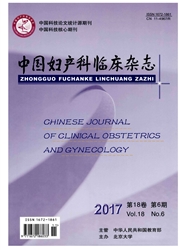

 中文摘要:
中文摘要:
目的 提高对妊娠期肺栓塞的认识和诊疗水平。方法 对上海市第六人民医院2009年2月至2016年9月收治的11例妊娠期肺栓塞患者进行回顾性分析。结果 妊娠期肺栓塞的发病率4.4/万。6例发生于妊娠期,5例发生于分娩期。9例患者有呼吸困难和胸闷的表现;2例患者表现为突发晕厥、休克及低氧血症。5例同时存在下肢深静脉血栓。11例患者治疗成功率90.9%:8例抗凝治疗(治愈),2例小剂量溶栓治疗(治愈),1例常规剂量溶栓治疗(死亡)。结论 增强对肺栓塞的诊断意识才能减少漏诊和误诊;CTPA是最有效的诊断手段;抗凝治疗是基础,建议小剂量溶栓治疗。
 英文摘要:
英文摘要:
Objective To improve the diagnosis and treatment of pulmonary embolism during pregnancy. Methods Clinical data of 11 patients with pulmonary embolism in Shanghai sixth People's Hospital between February 2009 and September 2016 were retrospectively analyzed. Results The incidence of pulmonary embolism during pregnancy was 4.4/ million, Six cases occurred during pregnancy and five were postpartum. 9 cases of pulmonary embolism were onset as breathing difficulty and sudden chest stuffiness. Two patients were characterized by sudden onset of syncope, shock and hypoxemia. Five cases also had deep vein thrombosis. Pulmonary embolism was confirmed in 10 patients with CTPA. 10 cases were cured: 8 cases were treated with anticoagulant therapy, and 2 cases were treated with low dose thrombolytic therapy. While 1 case treated with routine dose thrombolytic therapy was died. The success rate of the treatment was about 90.9%. Conclusions Alert to patients with high risk factors for respiratory circulatory symptoms is important. CTPA is the best diagnostic aid. Anticoagulation therapy is fundamental. Low dose thrombolytic therapy is suggested.
 同期刊论文项目
同期刊论文项目
 同项目期刊论文
同项目期刊论文
 期刊信息
期刊信息
